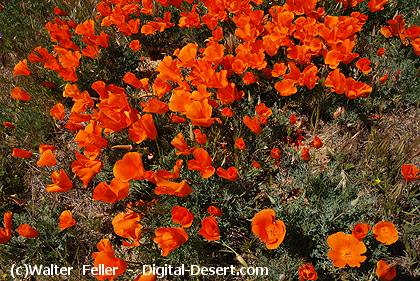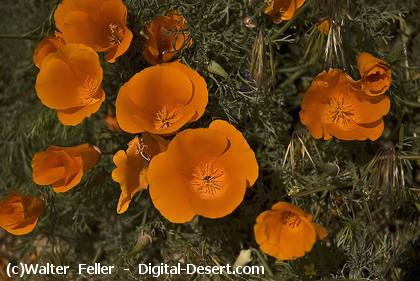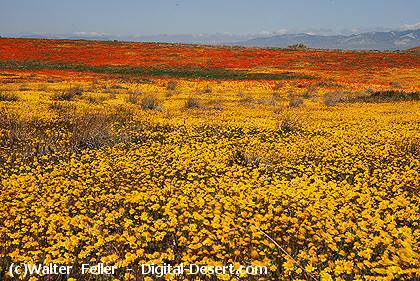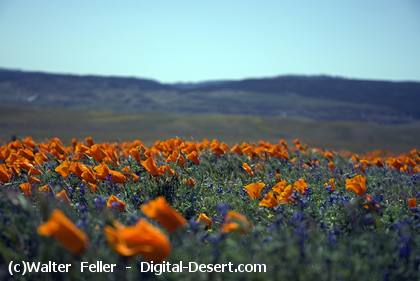--
Antelope Valley: West Mojave Desert
Antelope Valley Poppy Reserve
The Antelope Valley Poppy Reserve is established to protect and perpetuate outstanding displays of native wildflowers,
particularly the California Poppy, Eschscholtzia californica, the state flower.
The 1800 acre State Reserve, nestled in the Antelope Buttes 15 miles west of Lancaster, California is located on
California's most consistant poppy-bearing land. Other wildflowers: Oel's clover, lupine, goldfields, cream cups,
and coreopsis, to name a few, share the desert grassland to produce a mosaic of color and fragrance each spring. As
unpredictable as nature - the intensity and duration of the wildflower bloom varies yearly.
Seven miles of trails, including a paved section for wheelchair access, wind gently through the wildflower fields.
The broad views of this landscape provide eyefuls of brilliant wildflower colors. Whether you most enjoy
expansive fields of wildflower colors or the close-up study of a single flower, this is the place to visit. These
spectacular floral displays are maintained for the enjoyment, inspiration, and education of the people for all time to come.
Location - Directions
The Reserve is located 15 miles west of Lancaster at 15101 Lancaster Road.
From Highway 14: Take the Avenue I exit and head west 15 miles. Avenue I becomes Lancaster Road.
From I-5: Take Hwy 138 east and turn right on 170th Street West. Make a left at the end, onto Lancaster Road. Follow the road two miles.
Latitude/Longitude: 34º40.661 N, 117º49.645 W
The California Poppy
Eschscholtzia californica
The California Poppy was named the State Flower in 1903. Prior to that time great fields of Poppies were found
throughout the State. Today, while Poppies grow in many areas, the only large fields left are here in the western
Antelope Valley.
La Sabanilla de San Pasqual (The Altar-cloth of St. Pasqual) is the name Spanish sailors gave the glorious fields of
poppies which blanketed the California shores in the late 1700's. They were referring to the shepard saint who tended his
flock far from church and village and knelt in the fields of wildflowers to commune with God. It seems to be no coincidence
that the area in which the most spectacular fields of poppies grew came to be known as Rancho San Pasqual which is now
known as Pasedena, Altadena and Sierra Madre. Spanish Sailors described these fields as rivers of gold which flowed some
25 miles toward the ocean.
Other names for the California Poppy have been Copa de Ora (Cup of Gold), Ampola and Dormidera (meaning the sleepy one, for
the flowers close up at night and when it is cloudy or when the cold wind blows). The botanical name Eschscholtzia was given
to the plant by poet-naturalist Adelbert Von Chamisso of the Russian scientific expedition which visited California
in 1816. The name honored his lifelong friend and surgeon to the ship, Dr. Johann Eschscholtz.
Also see:
Source - California State Parks




